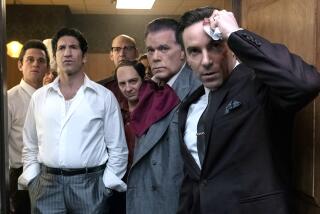TV Thinkers Focus on Early-to-Bed Audience : Quirk in the San Diego market prompts industry strategists to ponder adjustments in an attempt to corner the “early prime time.”
- Share via
SAN DIEGO — As if it needed to be articulated, people on the West Coast are different than people on the East Coast.
In San Diego, television viewing reaches a feverish peak at 9:45 p.m., far earlier than in the East. An hour later, according to industry analysts, most of these viewers are falling asleep.
This is one of the quirks of the San Diego market: People watch television earlier and go to bed earlier than in other areas.
To the big thinkers of the San Diego television industry, this little twist accents the importance of the 120 minutes between 6 and 8 p.m. each weeknight. In the battle for revenue among local television stations, this “early fringe” period is the front line.
During these hours, the stations make the big money and establish their identities. The viewers may see little more than a myriad of sitcoms, game shows and tabloid news programs, but there is a wealth of big money intrigue and strategy behind every programming move.
For each half-hour of network prime time (8 p.m.-11 p.m.), each local affiliate usually is able to sell four or five 30-second commercials. However, for local shows in fringe, each station keeps revenue from as many as 14 commercials per half hour.
By simple arithmetic, at $900 for 14 spots a night, five nights a week, the “A Current Affair” half-hour alone earns more than $3 million a year for Channel 10. KGTV’s Lundy estimates it costs his station $1 million a year to program the 7 to 8 p.m. slot, which now offers “A Current Affair” and “Family Feud.” Given the figures, it’s not hard to see why the stations place so much emphasis on the early fringe hours.
In San Diego, demand for commercial time during these hours is higher than ever before, as advertisers use the programs to target the free-spending, two-income families that tend to watch TV at that time of day. Prices for commercials during the early fringe programs have gone up an average of 8% to 10% in the last year alone.
“Generally speaking, for an independent TV station, 40 to 50% of its entire income is billed from 5 to 8 p.m.,” said Martin Colby, general manager of XETV (Channel 6), an independent that airs Fox network programming.
With so much at stake, the competition among the syndicated programming of local stations is rapidly changing, directly affecting the program choices available to viewers.
The audience is so large during the early fringe period, particularly from 7 to 8 p.m., that the networks occasionally discuss switching the start of their prime time programming from 8 p.m. to 7 p.m. on the West Coast to take advantage of viewers’ earlier habits.
Three California NBC affiliates were due to test the prime time switch next year, but the experiment has been put on hold by the network, which isn’t quite ready to relinquish the 10 p.m. hour to the affiliates.
However, other changes are more likely to occur--soon.
Looming on the horizon is the new “syndicated exclusivity” rule, commonly referred to as “Syndex,” scheduled to become law Jan. 1. If litigation by the cable industry to stop the measure is unsuccessful, Syndex will force cable networks to black out syndicated shows on out-of-town stations when the shows also air on San Diego stations. For example, if “A Current Affair” is shown on KGTV (Channel 10), cable systems will not show it when it airs on Los Angeles’ KTTV (Channel 11). (There will be exceptions--L.A. stations KCOP-TV (Channel 13) and KNBC-TV (Channel 4) will probably be exempt because they have long-established, significant viewing audiences in San Diego).
The rule is designed to ensure that stations buying exclusive rights for a program in San Diego actually is the only place San Diegans can see the show. It will be the responsibility of the TV stations to inform cable systems what shows they have exclusive rights to within the market.
Syndex will be particularly helpful to the independent stations airing sitcoms. And it will provide further focus to the competition among local San Diego stations.
“We won’t have to consider what the Los Angeles stations are doing as we did before,” said KTTY-TV (Channel 69) General Manager Jim Harmon. “I think it is going to be a great benefit for us.”
In general, the independent stations have become stronger competition for the network affiliates. From 6 to 8 p.m., San Diego’s independent stations--KTTY (Channel 69), KUSI (Channel 51) and XETV (Channel 6)--capture 24% of the audience, up 10% from two years ago.
The increase in the number of homes wired for cable in San Diego--now up to 77%--accounts for some of the increase, but the largest factor is certainly the improvement in the quality of programs available to the independent stations. Instead of “Different Strokes” and “Facts of Life,” the independents offer “Cheers,” “The Cosby Show” and “Night Court.”
For the independent stations, the sitcoms are a natural counter-programming move. Under federal law, from 7 to 8 p.m. the network affiliates cannot show programming that originated on any network. The law is designed to encourage the network affiliates to air a wider variety of locally oriented programming.
But the early fringe hours are too important for the network affiliates to take chances on expensive-to-produce local programming. It’s more cost-effective to bring in proven ratings successes. In the world of syndicated programming, shows like Channel 39’s “Wheel of Fortune” and “Jeopardy” are big winners, consistent ratings producers.
In general, the local network affiliates use the 7 to 8 p.m. slot to provide news- and family-oriented programming. KFMB-TV (Channel 8) offers “P.M. Magazine” and “Entertainment Tonight”; Channel 10 has “A Current Affair” and “Family Feud.”
“We’re trying to promote ourselves as an information station,” said Channel 10 Program Director Don Lundy. “That’s why we use shows like ‘A Current Affair.’ ”
“A Current Affair,” which Channel 10 moved into the 7 p.m. slot last season, is in almost a dead heat with “P.M. Magazine” and “Wheel of Fortune.”
When a show doesn’t work during the early fringe hours, it doesn’t last very long. When “Win, Lose or Draw” dropped to a relatively low 5 rating, Channel 10 quickly replaced it this fall with the more reliable “Family Feud.” Channel 39 stuck with “U.S.A Today” at 6:30 p.m. for a year, but it dropped it from the lineup, adding the tabloid-like “Inside Edition” at 7:30 p.m. instead.
Like a baseball team still paying a retired player, Channel 39 still owns the rights to “U.S.A. Today,” as well as another tabloid show, “Hard Copy.” Both are waiting in the wings, should “Inside Edition” not produce ratings.
Stations are not going to wait for unproven product to develop, nor, with few exceptions, are they willing to risk developing locally-produced programs. The stakes are too high.
“The reasons (advertisers) buy (time) from 6 to 8 is because they want the two-income couples, the working adults,” said Chuck Dunning, local sales manager for Channel 6. “Before 6 those people simply are not available.”
Advertisers consider San Diego an expensive market, because demand is high for commercial time during the early fringe hours. The recent increase in local ad rates is much higher than the national average.
“An example is San Diego is the 25th ranked TV market (in the country), but it’s 15th in revenues,” said Jim King, director of media services for Franklin and Associates. “It’s more of a sellers market here than in other markets.”
The average cost for commercial time from 7 to 8 p.m. is $120 per rating point. According to industry sources, Channel 10 charges $900 for a 30 second commercial during “A Current Affair.” (Actual prices for commercial times vary considerably, based on the number of commercials purchased and other considerations.)
Although still expensive, the prices for syndicated programming probably peaked two years ago when stations throughout the country paid exorbitant sums for “The Cosby Show.” Last year, KUSI was believed to have paid $3 million for 42-months of Cosby.
“The trend (in prices) is down significantly because ‘Cosby’ was so expensive and it wasn’t worth it,” said Colby of Channel 6. “Stations are no longer willing to make the judgement that if a ‘Cosby’ is No. 1 on the network it will be number one in syndication.”
There is also a wide variety of programming available to stations, evidenced by the abundance of tabloid news shows and “Current Affair” clones. (“The Oprah Winfrey Show” is Channel 10’s most expensive program. “She’s a monster,” Lundy said.)
In many ways the abundance of tabloid news shows programs, night time game shows and the other informational programs have been specifically developed to meet the demand for programming in the early fringe hours.
More to Read
The complete guide to home viewing
Get Screen Gab for everything about the TV shows and streaming movies everyone’s talking about.
You may occasionally receive promotional content from the Los Angeles Times.






